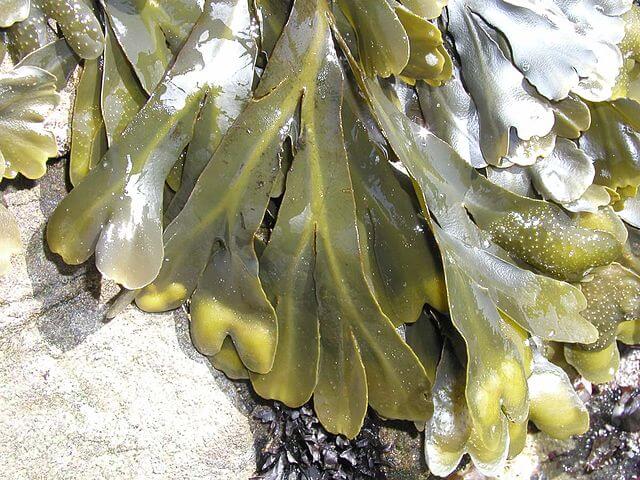Coastal foraging presents more options than the animal options that come to mind like mussels and clams, and your plant intake isn’t limited to only seaweed. A member of the Fucaceae family, Bladderwrack (Genus: Fucus) is a fairly short, forking algae. Also known by names such as rockweed, black tang, bladder fucus, and rockwrack, it grows in the wading waters of cool seas—namely the North and Baltic seas. It is also found in the northern parts of the Atlantic and Pacific oceans around North America. Bladderwrack’s usual harvest season can last from March through October, and as a perennial, it returns every year—making it a sustainable food source we can consciously forage.

The Wrack family is distinct in appearance, as most species sport some type of egg-shaped or oval pocket dotting the length of the algae—aiding in floatation. But never fear. Each member of the Wrack family is edible, so you don’t have to worry if you accidentally grab another kind. Bladderwrack is most easily confused with egg wrack, but it can be distinguished with a simple trick. Growing roughly one and half feet tall and greenish brown in color, bladderwrack’s forking blades have smooth edges, whereas egg wrack’s edges are rough and appear almost serrated. Bladderwrack gets its name from the air-filled bladders dotting either side of each leaf’s mid rib and looks more like seaweed than what one would normally consider to be algae.
Edibility and Culinary Use
Bladderwrack’s culinary use is often limited to a tea made by steeping a small portion of fresh or dried algae in boiling water. However, the high salt content imbued from sea water makes it an especially salty treat, which makes it great as an additive to soups and broths. Bladderwrack is safe to consume raw if you choose to add it to a salad or have a snack right on the beach, but it can also be dried and preserved for later consumption. Aim for harvesting the young tips of the algae if adding to soups to ensure a tender plant. However you choose to eat it, remember that it is important to watch your intake of this wild food because of its salt content.

Medicinal Uses of Bladderwrack
While completely edible, most people who consume bladderwrack choose to do so in the form of a capsule because of its strong, fishy taste. An ancient medicinal plant, it contains high amounts of iodine and was once prescribed as a treatment for iodine deficiencies and goiters. While the plant also shows anti-inflammatory promise because of its high vitamin and antioxidant count, recent studies have proven it to be a powerful topical to boost collagen and reduce the appearance of cellulite.
Cautions
Foraging is a sustainable and noble way to gather your meal, but please consume bladderwrack with caution. It is suggested to consult your doctor before consuming bladderwrack. Because of its high concentration of iodine, salt, and minerals, it can interact with several medications, herbal supplements, and even worsen an uncontrolled thyroid disorder. Women who are pregnant or breastfeeding should not consume bladderwrack, as its effects have not been studied with this population.
Conclusion
Quite a demand for this plant has sprung up within the beauty industry in recent years, with prices per pound skyrocketing. You are likely to pay a premium price for skincare products containing this valuable sea-weed (though it is algae, not seaweed). So, the next time you are frolicking at the beach, frustrated by the plant life wrapping around your toes, don’t forget that you could be standing on a traditional and adored source of life-saving medicine and sustenance.
Many of our readers find that subscribing to Eat The Planet is the best way to make sure they don't miss any of our valuable information about wild edibles.
See our privacy policy for more information about ads on this site






